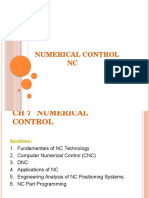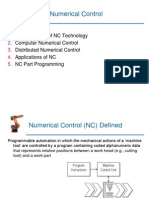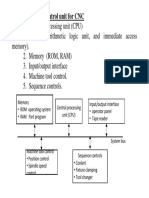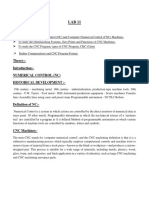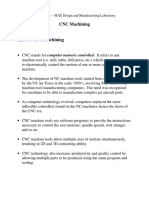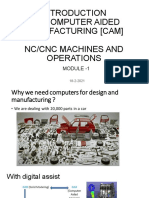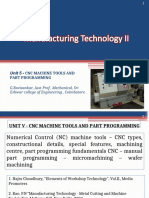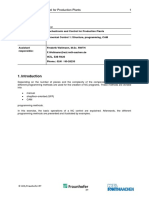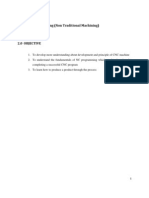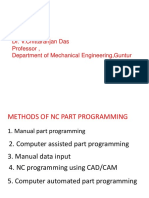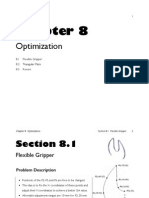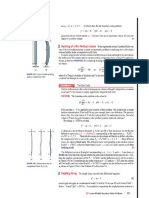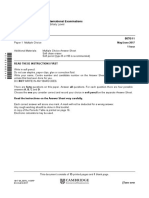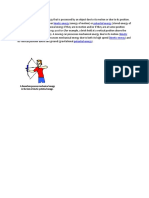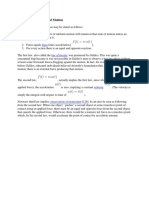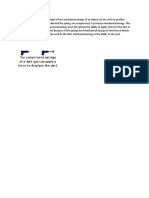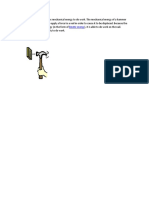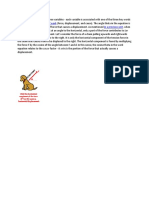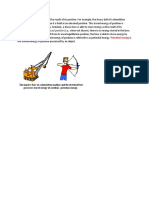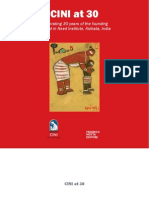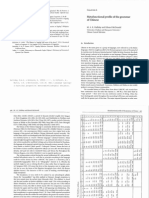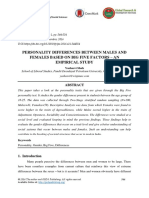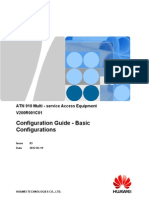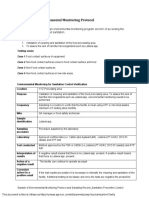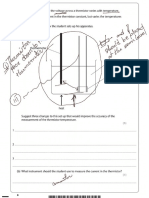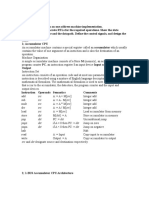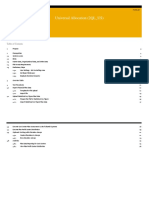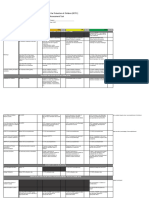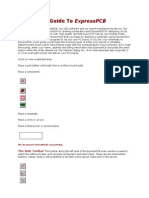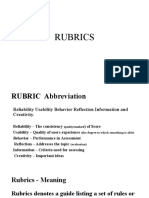11/4/2015
INTERPOLATION METHODS
Linear interpolation:
This is the most basic and used method when a straight line path
is to be generated in continuous path NC. The programmer
specifies the beginning point and end point of the straight line
and the feed rate to be used along the straight line. The
interpolator computes the feed rates for each of the two (or three)
axes to achieve the specified feed rate.
Circular interpolation:
This method permits programming of a circular arc by specifying
the following parameters: (1) the coordinates of the starting
point, (2) the coordinates of the endpoint, (3) either the center or
radius of the arc. The generated tool path consists of a series of
small straight line segments calculated by the interpolation
module.
INTERPOLATION METHODS
Helical interpolation:
This method combines the circular interpolation scheme for two
axes described above with linear movement of a third axis. This
permits the definition of a helical path in three-dimensional
space. Applications Include the machining of large Internal
threads.
Parabolic and cubic interpolation:
These routines provide approximations of free form curves using
higher order equations. Most applications are in the aerospace
and automotive Industries for free form designs that cannot
accurately and conveniently be approximated by combining
linear and circular interpolations
1
� 11/4/2015
THE COMPUTER’S JOB
Post-Processor
NC machine systems are different, they have different features
and capabilities
High-level programming languages are not intended for only
one machine tool type. They are designed to be general
purpose.
The final task of the computer in computer-assisted part
programming is post-processing, in which the CLFILE file is
converted into low-level code that can be interpreted by the NC
controller.
The output of post-processing is a part program consisting of
G-codes, x-, y-, and z-coordinates, S,F,M, and other functions in
word address format.
A unique post-processor must be written fro each machine tool
system.
2
� 11/4/2015
NC PROGRAMMING WITH INTERACTIVE GRAPHICS
There are several innovations in NC part programming during the
1980s.
1. Use of CAD/CAM
2. Voice programming
3. Manual data input (MDI)
USE OF CAD/CAM
The use of interactive graphics in NC programming is an excellent
example of the integration of computer-aided design and computer-
aided manufacturing.
Using the same geometric data which defined the part during the
computer-aided design process, the programmer constructs the
tool-path using high-level commands to the system.
In many cases the tool path is automatically generated by the
software of the CAD/CAM system.
The output resulting from the procedure is a listing of the APT
program, which can be post processed to generate the NC punched
tape.
All of the major CAD/CAM system vendors offer part programming
packages.
3
� 11/4/2015
PROCEDURE
The CAD/CAM procedure for NC programming begins with the
geometric definition of the part.
A significant benefit of using a CAD/CAM system is realized when
these geometric data have already been created during design.
The CAD/CAM systems accomplish the labeling of various surfaces
and elements of the geometry in response to a few simple
commands by the programmer.
After labeling is completed, the APT geometry statements can be
generated automatically by the system.
In addition to this facility, the part can be displayed at various
angles, magnifications, and cross sections to examine potential
problem areas in machining.
PROCEDURE
Also, with the part defined in the computer, the programmer
overlay the outline of the raw work-part to consider the number of
passes required to complete the machining.
Alternative methods of fixing the part can be explored using the
graphic terminal.
Tool selection is the next step in the procedure. The CAD/CAM
system typically have a tool library. The part programmer could
either select one of these tools or create a new tool design by
specifying the parameters.
At this point, the programmer has a geometric model of the work
part and the tools needed to machine the part. The next step is to
create the cutter path.
4
� 11/4/2015
PROCEDURE
The currently available commercial CAD/CAM systems use an
interactive approach, with certain common machining routines
being done automatically by the system (e.g. profile milling around
the part outline, end milling pocket, point-to-point, and surface
contouring).
As the tool is being moved on the CRT screen, the corresponding
APT motion commands are automatically prepared by the
CAD/CAM system.
At this stage the postprocessor statements (e.g. feed rate, speed,
and the control of the cutting fluid) can also be inserted.
The use of color graphics is also very helpful to the programmer.
The part can be displayed in one color, while the tool path would be
shown in a different color.
PROCEDURE
Another feature which aides visualization of the machining sequence
is dynamic tool path simulation on the screen.
The simulated tool motion can be displayed in any of several modes:
1. High speed motion, which reduces the time to verify the tool path.
2. Actual speed, which shows the tool feed at the commanded rate.
3. Freeze mode, which stops the tool motion for close inspection.
4. Stepping mode, which displays the tool path in discrete steps.
5
� 11/4/2015
ADVANTAGES OF CAD/CAM IN PROGRAMMING
See from the book page # 206.
VOICE PROGRAMMING
Voice programming of NC machines (VNC) involves vocal
communication of the machining procedure to a voice-input
NC tape-preparation system.
VNC allows the programmer to avoid steps such as writing
the program by hand, keypunching or typing, and manual
verification.
To perform the part programming process with VNC, the
operator speaks into a microphone designed to reduce
background noise.
Communication of the programming instructions is in shop
language with such terms as, turn, thread, and mill line,
together with numbers to provide dimensional and
coordinate data.
6
� 11/4/2015
VOICE PROGRAMMING
The entire vocabulary for the Threshold system contains
about 100 words.
Most NC programming jobs can be completed by using
about 30 of these vocabulary words.
In talking to the system, the programmer must isolate each
word by pausing before and after the word.
The pause must be only 1/10 of a second or longer.
Typical word input rates under this restriction are claimed
to be about 70/min.
As the words are spoken, a CRT terminal in front of the
operator verifies each command and prompt for the next
command.
EXAMPLE
A typical dialogue between the VNC system (printing on the
CRT screen) and the programmer (speaking) might go as
follows for defining a circle.
Programmer: “Define”
System: DEFINITION TYPE
Programmer: “Circle”
System: CIRCLE # =
Programmer: “Three”
System: CIRCLE PT X =
Programmer: “Five decimal three one, Go”
System: Y=
Programmer: “Two decimal four seven five, Go”
System: RADIUS =
Programmer: “One decimal five, Go”
System: CW/CCW
Programmer: “Counterclockwise”
7
� 11/4/2015
VOICE PROGRAMMING
When all the programming instructions have been entered
and verified, the system prepares the punched tape for the
job.
ADVANTAGES
1. Saving in the programming time up to 50%
2. Improvement in accuracy
3. Lower computer-skill requirement for the programmer.
MANUAL DATA INPUT (MDI)
Manual data input involves the entry of part programming
data through a CRT display at the machine site; hence the
use of punched tape is avoided.
The programming procedure is usually carried out by the
machine operator (not the part programmer).
NC systems equiped with MDI capability possess a
computer.
MDI systems are designed to facilitate the part
programming process by using an interactive mode to assist
the operator through the programming steps.
It queries the operator about the details of the machining
job so that the operator types in the program responding to
the sequence of questions.
8
� 11/4/2015
MANUAL DATA INPUT (MDI)
MDI units use shop language rather than alphanumeric
codes.
This removes some of the ambiguity, usually surrounding
the programming activity.
The programmer just needs to be able to read an
engineering drawing and familiar with the machining
process.
No extensive training is required in NC part programming.
The great advantage of MDI is its simplicity.
Since, no punched tape is employed with MDI, the shop is
spared the expense of tape punching equipment normally
associated with NC.
MANUAL DATA INPUT (MDI)
The limitation on MDI is that the programs should be
relatively short and simple.
The reasons for this limitation are
1. Since there is no paper copy of the program, there is a limit on the
length and complexity of the program that the operator is capable
of visualization.
2. The CRT can display a total of 22 or 25 lines, which adds to the
operator’s visualization problem.
One of the biggest disadvantages of MDI is that the machine
tool itself is not productive while programming is being
accomplished.
9
� 11/4/2015
MANUAL DATA INPUT (MDI)
The more complicated the program, the more time is taken
when the machine is not cutting metal.
One way of overcoming this problem, is for the machine to
be operated in a background mode.
The particular features of MDI make it suitable for work-
parts which are simpler than usual NC jobs.
PRECISION IN NC POSITIONING
For accurate machining by an NC system, the positioning system
must possess a high degree of precision.
Three measures of precision:
1. Control resolution
2. Accuracy
3. Repeatability
10
� 11/4/2015
CONTROL RESOLUTION
Control resolution is defined as the distance separating two adjacent
addressable points in the axis movement.
Addressable points are locations along the axis to which the
worktable can be specifically directed to go.
It is desirable for control resolution to be as small as possible.
Control
resolution
Bit storage
Electromechanical
capacity of the
components
controller
· Lead-screw pitch
· Gear ratio
· Step angle
· Angle b/w encoder slots
CONTROL RESOLUTION
Control resolution of the electromechanical system
For open-loop positioning system:
p
CR1
ns rg
For closed-loop system
p
CR1
ns rg rge
11
� 11/4/2015
CONTROL RESOLUTION
Control resolution of the computer system
The ability to divide the axis range into individual increments
depends on the bit storage capacity in the control memory
The number of increments = 2n
n = number of bits in the control memory
Control resolution
L
CR2
2 1
B
Control resolution of the overall positioning system
CR Max CR1, CR2
CONTROL RESOLUTION
A desirable criterion is for CR2 < CR1, meaning the electromechanical
system is the limiting factor.
The bit storage capacity of modern computer controller is sufficient
to satisfy the requirement.
Resolutions of 0.0025 mm is within the current state of NC
technology.
12
� 11/4/2015
ACCURACY
The accuracy of any given axis of a positioning system is
the maximum possible error that can occur between the
desired target point and the actual position taken by the
system.
ACCURACY IN IDEAL CASE
13
� 11/4/2015
MECHANICAL ERRORS
The capability of a positioning system to move the
worktable to the exact location is limited by the following
mechanical errors.
1. Play between the lead-screw and the table
2. Backlash in the gears
3. Elastic deflection in the structural members
4. Stretching of pulley cords
ACCURACY IN REAL CASE
Assumptions
1. Mechanical errors form an normal distribution about
the control point whose mean is 0
2. Standard deviation is constant over the range of the
axis.
Accuracy is defined under worst case conditions in which
the desired target point lies in the middle between two
adjacent addressable points.
Since the table can only be moved to one or the other of
the addressable point, there will be an error in the final
position of the work-table.
14
� 11/4/2015
ACCURACY IN REAL CASE
This is the maximum possible positioning error.
Mathematically
CR
Accuracy 3
2
REPEATABILITY
Repeatability
refers to the capability of the positioning
system to return to a given addressable point that has
been previously programmed
Re peatability 3
15
� 11/4/2015
REPEATABILITY
Suppose the mechanical inaccuracies in the open-loop
system are described by a normal distribution with
standard deviation 0.005 mm. The range of the worktable
axis is 1000 mm, and there are 16 bits in the binary
register used by the digital controller to store the
programmed positions. Other relevant parameters are;
pitch = 6.0 mm, gear ratio between motor shaft and lead-
screw rg = 5.0, and number of stop angles in the stepping
motor ns = 48. Determine
a. Control resolution
b. The accuracy
c. The repeatability for the positioning system
REPEATABILITY
Control resolution is the greater of CR1 and CR2
p 6.0
CR1 0.025mm
ns rg 48 5.0
1000
CR2 0.01526mm
216 1
CR Max 0.025,0.01526 0.025mm
Accuracy
0.5(0.025) 3(0.005) 0.0275mm
Repeatability
3(0.005) 0.015mm
16
















